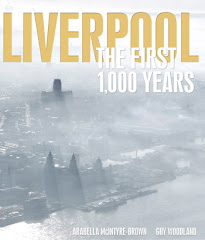
Hard to imagine, perhaps, but 100, even 50 years ago Liverpool looked very different to the city we know today. One of the world’s most famous waterfronts was only built in the first dozen years of the 20th century, after all, and the May Blitz destroyed so much of the city centre that photos of Liverpool in the 1930s are often hard to recognise as today’s city. But go back in time some 4,000 years and there wasn’t even the River Mersey. In the Neolithic period, about 2000 BC, this area was marshland and forest stretching miles alongside a big lake that extended about 30 miles from Warrington to Bootle (as we know them now). A primeval forest of oak, pine and birch stretched from Freshfield south-west across the top of the Wirral; some ancient oak tree stumps have been uncovered – a piece of oak from Leasowe has been carbon-dated to about 1740 BC….
The earliest evidence we have of a settlement is the Calder Stones, now in the park named after them to the south of the city centre. The very rare megalithic tomb, older than Stonehenge, was composed of a dozen or more sandstone blocks that made up the burial chamber at the heart of a sand tumulus. Some of the stones were carved with cup and spiral markings – the only examples in England. In 1840 the stones themselves were moved when the road was widened, and lay in a local farmer’s field acting as cattle rubs till Joseph Walker set six of them in a circle in front of his house. Only in 1954 did the Liverpool Corporation move the stones into a greenhouse within Calderstones Park, where they remain…..
It is not Liverpool that gets the first mention in records, but Halewood – part of the little village of Hale to the south of Liverpool; the Wood of Hale appears on the map in 1001 AD according to the Domesday Book. Next on the roll comes the River Mersey, mentioned in a document of 1004 during the reign of Ethelread II. In the Domesday Book (1086) there is still no mention of Liverpool itself, although Smithdown, Toxteth and West Derby are named. The very first mention of Liverpool is in a deed signed by Prince John in 1190 (while his brother Richard I was off crusading): ‘Know ye that we have granted, and this by our deed confirmed, to Henry Fitzwarine, son of Warine of Lancaster, the lands which King Henry our father gave to Warine his father, that is Ravensmeols, Ainsdale, Litherland, Liverpool and French Lea.’
In 1561 there were 690 people living in 138 cottages in the town’s seven inhabited streets: Chapel Street, Castle Street, Dale Street, Bancke (now Water) Street, Moor (now Tithebarn) Street, Juggler (now High) Street, and Peppard (now Old Hall) Street. Liverpool as yet was not attracting much maritime trade anyway – and this wasn’t helped by the destruction of the haven by the great storm of 1560.
It is said that the coming of the age of steam has been one of a handful of key developments in western civilisation – the beginning of globalisation. Certainly for Liverpool the transformation was radical – after all, it was only in 1760 that the first stagecoaches linked Liverpool and London; 60 years later the trains made Liverpool a gateway between old and new worlds. The speed of change had made a quantum leap.
Now that the first 1,000 years of recorded history are complete, Liverpool is already steaming full ahead into its second millennium. With such an extraordinary history behind it, what must Liverpool’s future hold?

No comments:
Post a Comment